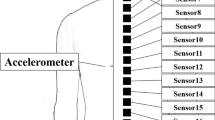Abstract
We describe the characteristics of displacement of the head and hip in normal young subjects standing on a moving platform undergoing continuous sinusoidal horizontal translation in the antero-posterior direction, at frequencies ranging from 0.1–1 Hz. The head, hip and malleolus were marked by light-emitting diodes (LEDs), and the displacement of each LED was quantified by (1) the measure of the shift during each cycle of translation, (2) the standard deviation (SD) of the path travelled during the whole trial, (3) the power spectrum (PS) of the signal and (4) the cross-correlation (CC) between pairs of LED signals. At each frequency of translation, with eyes open (EO), the displacement of head was smaller than that of hip, and the displacement of hip was smaller than that of malleolus. With eyes closed (EC), this order was reversed. The peak value of the CC functions of the pairs malleolus/head, malleolus/hip and hip/head decreased by passing from low to high frequency of translation, under both visual conditions, and decreased more for the pair malleolus/head than malleolus/hip. The lags between body segment displacements ranged between 30 ms and 150 ms, on average, the former segment of each pair preceding the latter. The fast Fourier transformation of hip and head displacement showed a power spectrum peak at the frequency imposed by the platform translation. The peak was larger with EC than EO. With EC, another peak appeared at 0.2 Hz, possibly corresponding to the respiratory frequency. We conclude that, when vision was allowed, subjects behaved as a non-rigid, non-inverted pendulum, and stabilised head in space. When vision was denied, head oscillated more than the platform, especially at low translation frequencies. Therefore, the strategy of balance control shifted from a pendulum to an inverted-pendulum behaviour, passing from active head-and-trunk control to maximal body compliance to the perturbation.
Similar content being viewed by others
Author information
Authors and Affiliations
Additional information
Received: 20 April 1998 / Accepted: 8 November 1998
Rights and permissions
About this article
Cite this article
Corna, S., Tarantola, J., Nardone, A. et al. Standing on a continuously moving platform: is body inertia counteracted or exploited?. Exp Brain Res 124, 331–341 (1999). https://doi.org/10.1007/s002210050630
Issue Date:
DOI: https://doi.org/10.1007/s002210050630




